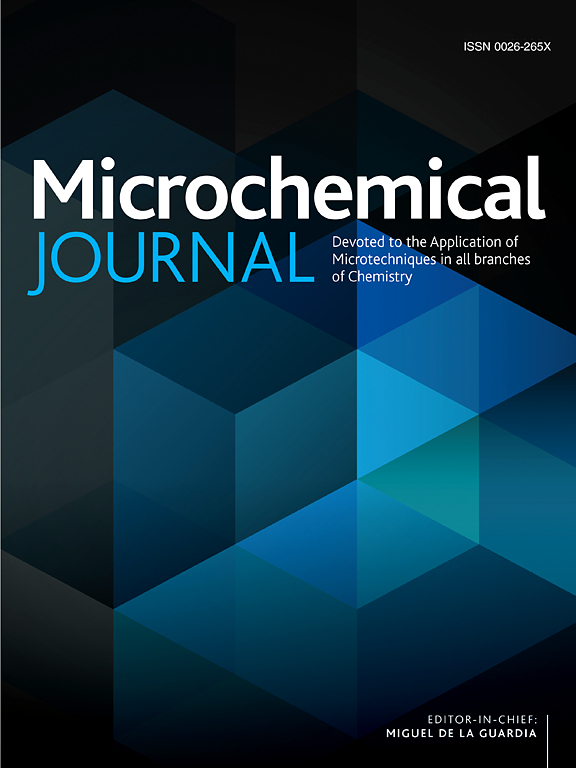Sensitive and facile photoelectrochemical and colorimetric dual-mode analysis of H2S based on MOF-derived TiO2/C@Au@Cu(II) nanodisk
IF 4.9
2区 化学
Q1 CHEMISTRY, ANALYTICAL
引用次数: 0
Abstract
Considering the severe toxicity and potential harm of hydrogen sulfide (H2S) released during agricultural and industrial activities, the development of sensitive and reliable method to measure H2S is worthwhile for environmental monitoring and human health. Here, the Cu(II) ions were introduced into MIL-125-derived TiO2/C@Au nanodisk (denoted as TiO2/C@Au@Cu(II)) and worked as the recognition elements. The H2S could react with Cu(II) ions to generate CuS, resulting in a reduction in photocurrent and an augment in absorption. Based on this, a sensitive and facile photoelectrochemical (PEC) and colorimetric dual-mode sensing platform was designed for H2S detection. In PEC mode, the steric hindrance of CuS obstructed the transport of photoexcited charge carriers and the diffusion of electron acceptor/donor between the electrode and electrolyte solution. Thereby, a quenching of the photocurrent signal was observed. For colorimetry, using the peroxidase-mimicking activity of CuS, the color reaction of 3, 3′, 5, 5′-tetramethylbenzidine (TMB) in the presence of H2O2 was triggered, causing an obvious absorbance response of colorimetric solution. Noticeably, the dual-mode detection exhibited a wide linear scope of 1 – 5 × 105 nM for H2S, achieving detection limits of 0.33 and 0.41 nM, respectively. Furthermore, this method presented numerous merits, containing high specificity, remarkable reliability, simplicity, cost-effectiveness and time-efficiency, highlighting its application prospects in environmental analysis and human safety.
基于mof衍生TiO2/C@Au@Cu(II)纳米盘的H2S光电化学和比色双模分析
考虑到工农业生产过程中硫化氢(H2S)的严重毒性和潜在危害,开发敏感可靠的硫化氢测量方法对环境监测和人类健康具有重要意义。本文将Cu(II)离子引入mil -125衍生的TiO2/C@Au纳米片(记为TiO2/C@Au@Cu(II))中,作为识别元件。H2S可以与Cu(II)离子反应生成Cu,导致光电流降低和吸收增加。在此基础上,设计了一个灵敏、简便的光电化学(PEC)和比色双模传感平台,用于H2S检测。在PEC模式下,cu的位阻阻碍了光激发载流子的输运和电子受体/给体在电极和电解质溶液之间的扩散。因此,观察到光电流信号的猝灭。在比色法中,利用CuS的过氧化物酶模拟活性,触发3,3 ',5,5 ' -四甲基联苯胺(TMB)在H2O2存在下的显色反应,使比色溶液有明显的吸光度响应。值得注意的是,双模检测对H2S具有1 ~ 5 × 105 nM的宽线性范围,检测限分别为0.33 nM和0.41 nM。此外,该方法具有特异性高、可靠性好、操作简单、经济高效、省时等优点,在环境分析和人体安全方面具有广阔的应用前景。
本文章由计算机程序翻译,如有差异,请以英文原文为准。
求助全文
约1分钟内获得全文
求助全文
来源期刊

Microchemical Journal
化学-分析化学
CiteScore
8.70
自引率
8.30%
发文量
1131
审稿时长
1.9 months
期刊介绍:
The Microchemical Journal is a peer reviewed journal devoted to all aspects and phases of analytical chemistry and chemical analysis. The Microchemical Journal publishes articles which are at the forefront of modern analytical chemistry and cover innovations in the techniques to the finest possible limits. This includes fundamental aspects, instrumentation, new developments, innovative and novel methods and applications including environmental and clinical field.
Traditional classical analytical methods such as spectrophotometry and titrimetry as well as established instrumentation methods such as flame and graphite furnace atomic absorption spectrometry, gas chromatography, and modified glassy or carbon electrode electrochemical methods will be considered, provided they show significant improvements and novelty compared to the established methods.
 求助内容:
求助内容: 应助结果提醒方式:
应助结果提醒方式:


